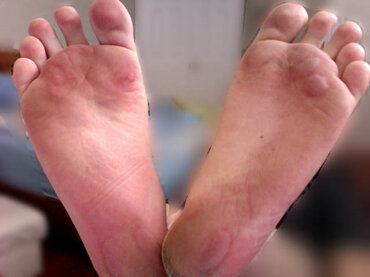A blister is a raised area of skin that is filled with a clear liquid over which the skin is intact. They form when that area has been damaged by pressure, chemicals that have been applied to the area, burns, insect bites, allergies, fungal or viral infections.
What causes a blister?
Blisters formed from pressure often occur on the feet, from new footwear or after a sporting activity, and from changing from casual summer shoes to more formal, constricting footwear. Blisters also occur from overuse, such as on the hands after repetitive actions with tools and devices, like from the handle of a spade after digging in the garden.
Complications of blisters
Blisters intact usually heal quickly without any scarring. If a blister breaks then there is a risk of infection and the following may occur:
- Pain
- Wound infection: presents with increasing pain and redness around the blister, a red streak heading for the groin or armpit, and pus formation. Infection is more common in diabetics and immune impaired individuals.
- Pyogenic granuloma may occasionally arise at the site of a blister some days later.
- Scarring due to infection or deeper injury.
Treatment and Prevention
If the blister has been caused by friction or pressure:
Treatment: Relieve the pressure by padded dressings and bandages and soft footwear or protective gloves when undertaking activities that may cause further damage.
If the skin has been damaged by a burn or from irritant substances:
Treatment: Cool the area or rinse away the irritant with cool water – if possible hold the blistered area under a running cold water tap, or use wet towels over the burned or damaged area, changing them frequently to ensure the irritant has been removed and the area cooled.
If blisters is a result of an infection, bite or allergy:
Treatment: Consult your community pharmacist. They will be able to give you specific advice to treat the underlying condition and to prevent further blisters occurring.
The most important treatment for a blister is to avoid breaking the skin over the blister. The fluid that is contained in the blister will disappear over the next few days and no infection should arise if the skin surface is not further damaged. These blisters are generally only painful when pressure is applied to them.
In order to prevent blisters and other skin damage remember to protect the skin with socks, soft comfortable footwear that is neither too large or too tight, and use gloves to protect your hands from friction and pressure damage, as well as from irritant chemicals.
Your community pharmacist is able to give you help and advice if you need to seek further help to treat the damaged or infected areas of skin affected by blisters.







